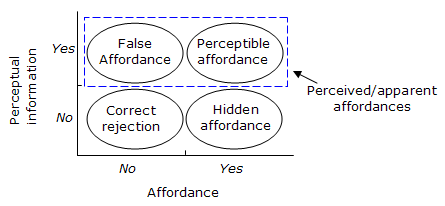The concept of Affordance isn't limited to the designer's capacity for developing objects following an easily recognisable pattern. Affordance also includes visual clues, the way that a user views an object should be enough for him to know how to effectively use it without previous instruction or reading. How to make use of an object without having to stop now and then to reorient himself wondering what to do next. A cursory glance down the object's physical frame should be enough to know right away how to handle it. It shouldbe clear by now that affordance relies on the user's world knowledge to navigate mundane surroundings. Good rules of affordance requires a balance between the individual variety within the users contingency and the multifaceted assortment of elements that make up the object features. For affordance to occur completely, cultural, physical, logical and psychological variables have to be fatored in.
William Gaver divided affordances into three categories: perceptible, hidden, and false.
A false affordance is an apparent affordance that does not have any real function, meaning that the actor perceives nonexistent possibilities for action. A good example of a false affordance is a placebo button.
A hidden affordance indicates that there are possibilities for action, but these are not perceived by the actor. For example, it is not apparent from looking at a shoe that it could be used to open a wine bottle.
For an affordance to be perceptible, there is information available such that the actor perceives and can then act upon the existing affordance.

No comments:
Post a Comment